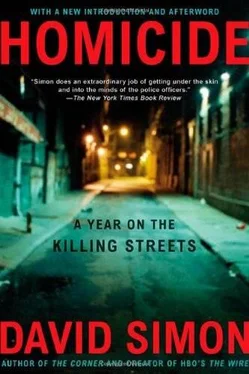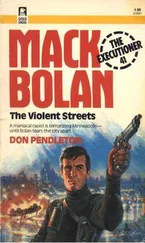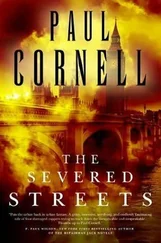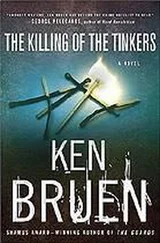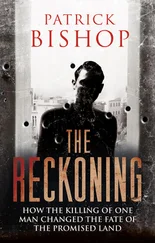SATURDAY, OCTOBER 1
Up and down the stoops he goes, a homicide detective banging on North Durham Street doors in search of a little cooperation, a little civic responsibility.
“Didn’t see it,” says the young girl at 1615.
“I heard a loud bang,” says the man at 1617.
No answer at 1619.
“Lord,” says the woman at 1621, “I don’t know nothin’ ’bout it.”
Tom Pellegrini presses a few additional questions on these people, trying hard to get himself interested in this case, to find something that might make a detective care about the bloodstain in the center of the 1600 block.
“Were you home when it happened?” he asks another girl, at the door of 1616.
“I’m not sure.”
Not sure. How can you not be sure? Theodore Johnson was hit by a shotgun blast fired at point-blank range, blown apart in the center of a narrow rowhouse street. The sound itself had to be audible all the way up to North Avenue.
“You don’t know if you were home?”
“I might have been.”
So much for the door-to-door canvass. Not that Pellegrini can blame the neighborhood for its reluctance to volunteer information. Word is out that the dead man crossed a local dealer on a drug debt and the dealer has just proven to everyone within earshot that he’s a man to be reckoned with. The people behind these doors have got to live on Durham Street; Pellegrini is no more than an occasional tourist.
With nothing on the horizon even remotely resembling a witness, Pellegrini has a body on the way to Penn Street and a bloodstain on dirty asphalt. He’s got a spent shotgun shell ejected by the shooter in the alley around the corner. He’s got a street so dark that the emergency vehicle unit has been called to light up his scene for the photographs. An hour or so later, Pellegrini will have the sister of his victim sitting in Jay Landsman’s office, feeding him a bit of rumor about some people that may or may not have had something to do with the shooting. He will have a headache, too.
Theodore Johnson joins Stevie Braxton and Barney Erely on the white rectangle in the coffee room. Braxton, the kid with a long sheet found stabbed up off Pennsylvania Avenue. Erely, the homeless man bludgeoned to death on Clay Street. Red names riding the board with Pellegrini’s initial near them, casualties in the year-long campaign to close the Latonya Wallace murder. It’s triage, plain and simple, but Pellegrini can live with that. After all, he’s got an eleven-year-old raped and murdered, and neither Theodore Johnson nor a drug debt that has now been paid has any real weight when hung in the balance. Tonight’s dead man will get one or two shakes from the homicide unit, one or two go-rounds in the interrogation rooms with a few reluctant witnesses. But then the primary investigator will set the file aside.
Months later, Pellegrini will feel some guilt about this, some concern about the number of cases sacrificed for the sake of one child. With much the same sort of self-recrimination that governs his thoughts on the Latonya Wallace murder, Pellegrini will wonder whether he should have pressed harder on that kid in the Western District lockup back in January, the one who claimed to know one of the shooters from Gold and Etting. He’ll wonder about whether he should have gone harder at Braxton’s girlfriend, who didn’t seem all that upset about the murder. And he’ll wonder, too, about the rumors that Theodore Johnson’s sister is now feeding him-information that will never be fully checked.
True, he could dump this case on the secondary. Vernon Holley handled the scene with him and he would probably understand if Pellegrini ducked the call to stay focused on Latonya Wallace. Still, Holley is new to the squad, a veteran black detective transferred from the robbery unit to replace Fred Ceruti. He’d been out on one murder with Rick Requer a couple of weeks ago, but that wasn’t enough to qualify as an orientation, even for an investigator as experienced as Holley. And the squad was a man short to begin with: Dick Fahlteich had voluntarily transferred to sex offense after six years in homicide. The body count had finally got to Fahlteich, a talented detective who nonetheless was handling fewer calls each year, working at a pace that others in Landsman’s squad were quick to compare to Harry Edgerton’s. The workload and the hours-coupled with a gnawing aggravation about his being passed over several times on the sergeant’s lists-had at last pushed Fahlteich down to the other end of the sixth-floor hallway at about the same time that Ceruti traveled the same route. At least with Fahlteich it was a matter of choice.
No, Pellegrini reasons, with the squad down to three regulars and a fresh transfer, the Theodore Johnson case is his to eat. At the very least, he owes it to Holley to stay with the thing for a few days. A graphic display of job-related burnout isn’t exactly the best lesson to be teaching a new man.
Bravely, Pellegrini fights his own impulses, doing a competent crime scene out on Durham Street, then canvassing the entire block for witnesses that he knows in his heart will never come forward. Holley peels off early, heading back to the homicide office to begin interviewing family members and a couple of kids at the scene who were sent downtown only because they were out there acting like squirrels when the first uniforms arrived.
The sudden role reversal-with Pellegrini now the tired veteran, breaking in the latest prodigy-is accepted without comment by everyone else in Landsman’s squad. Nine months of Latonya Wallace has changed Pellegrini: His metamorphosis from fresh-scrubbed recruit to battered trench rat is complete. To say that he can look at Holley and see himself a couple years ago goes too far: Holley already had the experience of CID robbery behind him; Pellegrini had come to homicide with no investigative background whatsoever. Still, Holley is working this Durham Street case as if it mattered, as if it were the only murder in the history of the world. He is fresh. He is confident. He makes Pellegrini feel one hundred years old.
The two detectives chase the murder on Durham Street through into late morning, gathering the information from the sister, then trying to check her story against that provided by a former police officer who has family living in the block. His family will not come forward, but the ex-cop, though fired from the force twenty years ago in a corruption case, has enough residual instinct to call in with the name of a possible participant. Pellegrini and Holley find the kid that same morning, go at him in the large box for several hours and emerge with little to show for the effort. Then, slowly, after a few more laps around the case file, Holley accepts the unspoken verdict of his tutor. He drifts away, looking for better pickings with Gary Dunnigan and Requer.
He finds them, too, hooking up with Requer on a domestic from Bruce Street, a true tragedy in which a young girl has been bludgeoned to death by her cokehead of a boyfriend and her orphaned infant is left crying on a policewoman’s shoulder, wailing at the world as the officer’s hand-held radio squawks out citywide dispatch calls. Holley follows that with another domestic from Cherry Hill that he works to completion with Dunnigan. Both cases are dunkers and both bring a certain confidence. By December, Holley will be handling calls as a primary.
For Pellegrini, however, the milestones marked by his squad mean little. Ceruti’s fall from grace, Fahlteich’s departure, Holley’s education-they are scenes from a play in which Pellegrini has no real part. Time stands still for one detective, leaving him alone on a stage of his own, trapped there by the same few props and the same few lines from the same sad scene.
Читать дальше
